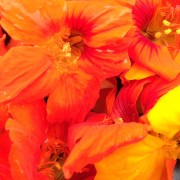Nasturtiums
Often the first bite of many in the realm of edible flowers is the common nasturtiums (tropaeolum majus). Not only are its bright, vividly colored flowers (deep red orange, orange, yellow) edible but so are its large, lilypadlike leaves and its stems. Though those flowers look as sweet as candy, it can have a mildly radish like kick.
It originated in the region of Peru and was introduced to Europe in the 17th century. It is now found growing wild along the Pacific coast of the U. S. It is fairly easy to grow in a garden patch, seeds of single and double blossom as well as single or multi-colored variety can be found by especially heirloom and herb seed sellers.
Their leaves are known to be good sources of vitamin C and iron.
Prepping and Eating Tips
– Always gently wash your flowers before eating them.
– Nasturtium leaves and flowers can be eaten raw, a spicy addition to any salad. Make sure you dry them first so they can commingle with your dressing.
– Its leaves can be stuffed like grape leaves or cooked like a soft delicate green such as spinach.
Selecting and Storing Tips
Select leaves and flowers that are vibrant in color and supple, avoid wilt. Nasturtium are fairly fragile, so once harvested or purchased, should be eaten right away.
Stored in the refrigerator in an air tight container or bag, unwashed for up to 3 days.
boldenona pre?o tramadol buy online
